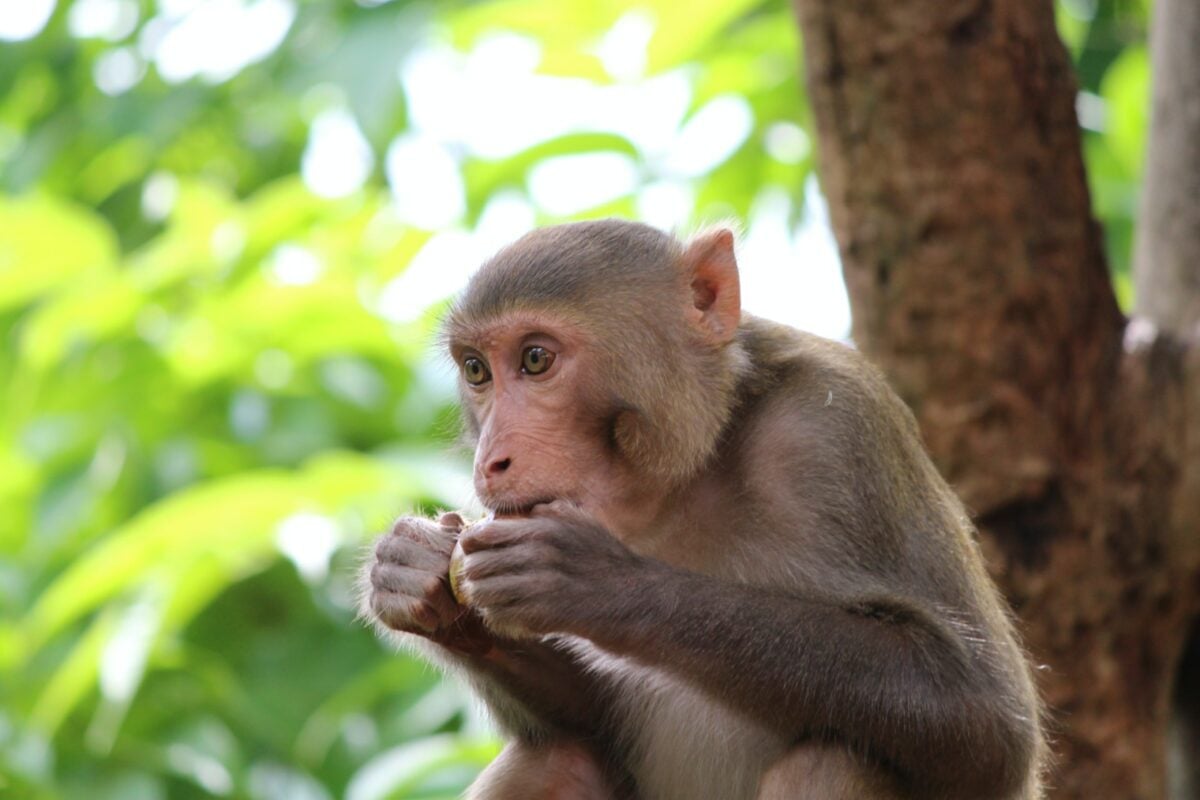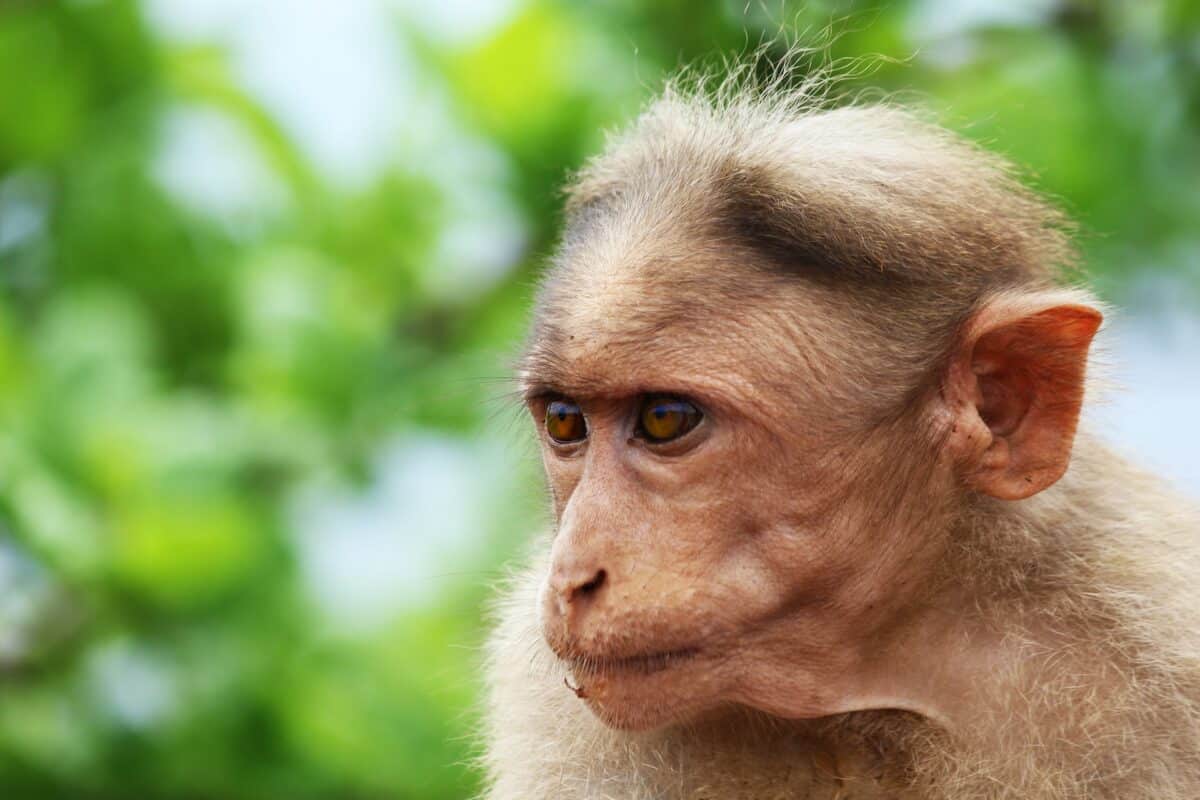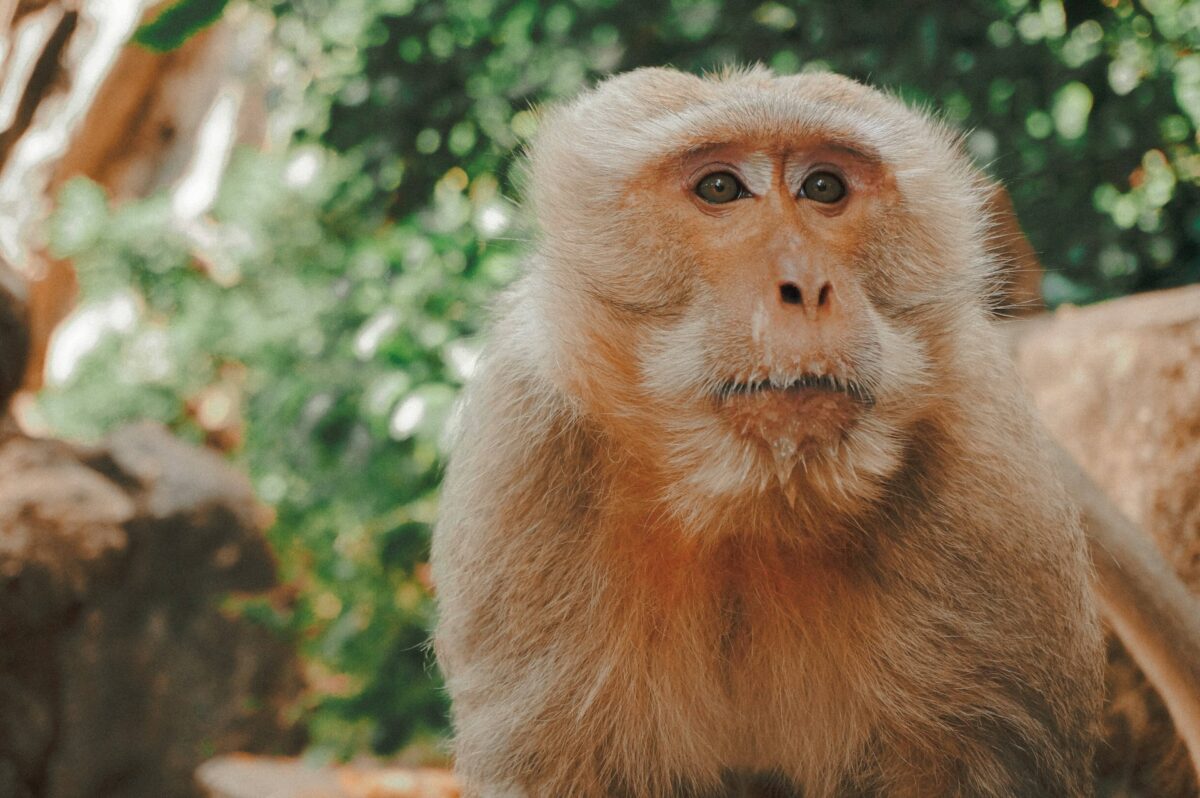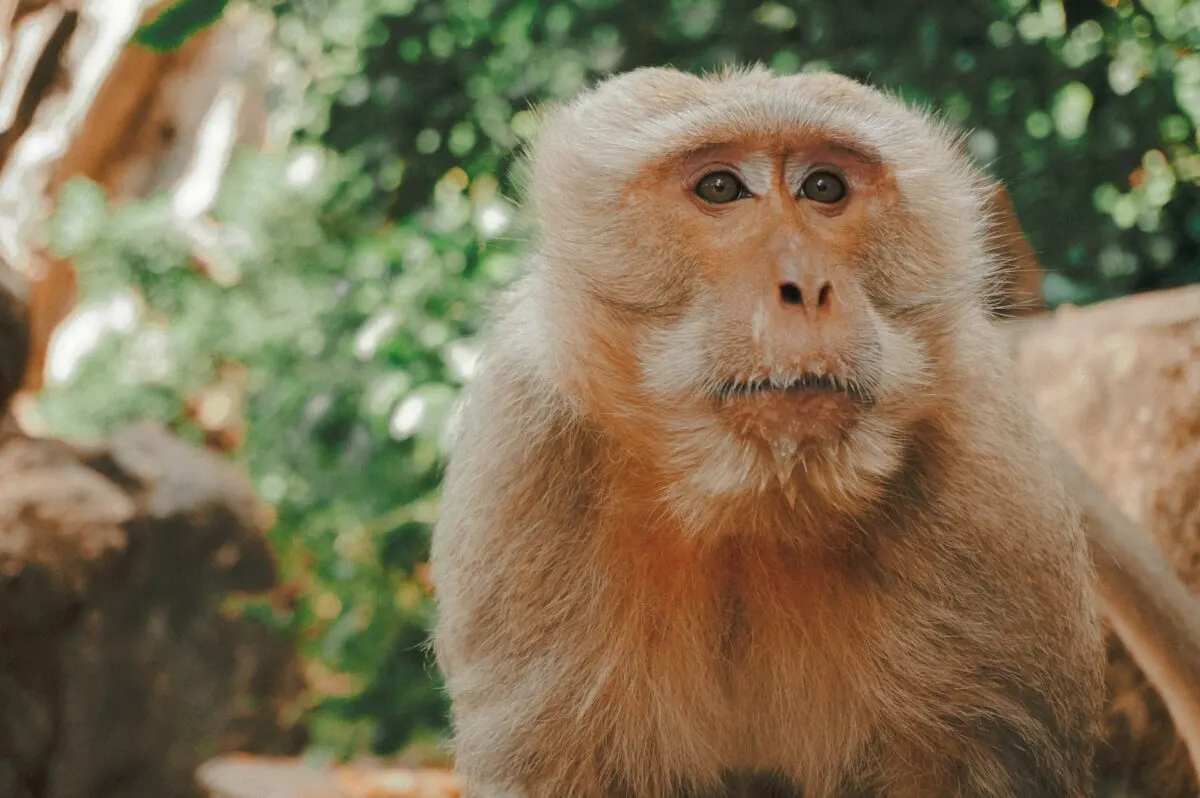Albino monkeys are one of the cutest creatures that give a first impression of a cute and mischievous being. When digging deeper and learning about various monkey species, you may be surprised to know that there are some really fascinating species that we didn’t know existed.

Unlike most monkeys with dark hair, albino monkeys are white or pale in appearance due to their being born without pigmentation in their skin. So, focusing on their appearance, they appear more innocent and beautiful compared to monkeys with darker hair.
These little mammals are packed with interesting characteristics and features. Today, we will discuss Albino monkeys, including their lifestyle and behavior. So, without wasting time, let’s dive into the details.
Get To Know the Albino Monkey

Albino monkeys are a particular species born without any pigment in their skin, bodies, hair, and eyes. These monkeys are more susceptible to sunburns and skin diseases because they have little to no protection from the sun.
Monkeys with Albinism are often quite pale in color and have red eyes. They frequently have diminished fertility as well as eyesight issues. Their populations are typically small and located remotely as a result.
Since Albino monkeys are a monkey species that is born with a deficiency, they will not typically roam freely around like other monkeys.
Appearance
Albino monkeys have white hair, red eyes, and white skin, giving them quite a different appearance than ordinary monkeys. Like regular monkeys, they come in various sizes, starting with the pygmy marmoset.
They can grow as small as 4.6 inches (11.7 cm) with a 6.7-inch (17 cm) tail and weigh about 3.5 ounces (99 g). Other species can get up to 3.5 feet (1 m) long and 80 pounds (36 kg) in weight.
Habitat
The habitat of albino monkeys depends on the specific species of monkey. Some common habitats for albino monkeys include:
1. Rainforests: Many monkeys, including albino individuals, can be found in tropical rainforests. The dense, lush forests provide plenty of food and shelter.
2. Savannas: Some monkeys, like mandrills, live in savanna habitats, and Albino monkeys often share the same place. Dispersed trees and herds of grazing mammals characterize these grassland ecosystems.
3. Mountain forests: Some monkeys, including Albinos and white-faced capuchins, live at high elevations in mountain forests. These cool, misty habitats with dense vegetation and are home to various animals.
4. Urban areas: also provide a natural habitat to Albinos and other monkey species who have adapted to living in urban areas. You can often find these monkeys in and around towns and cities, where they have adapted to survive on a diet of human food and other resources.
Lifespan
The lifespan of albino monkeys is usually slightly less than that of non-albino individuals of the same species, due to their susceptibility to certain diseases. Monkeys can live for about 20–30 years in the wild and up to 35 years in captivity.
However, the lack of pigmentation may affect their survival and lifespan, as they are more susceptible to certain health issues such as sunburn and skin cancer.
Nature
They develop close friendships and savage rivalries like other monkey species, interacting with one another individually in a sophisticated social structure. They stand up for one another and look out for each other.
Monkeys will recall previous interactions and the assistance of a friend when they come into contact. They experience stress, much like we do, and it frequently seems to be related to societal issues.
While some experts contend that monkeys and apes may not necessarily comprehend death in the same way we do, they seem to share our propensity to have difficulty accepting it.
For instance, monkey mothers who have lost their young appear to be particularly affected. In almost all monkey species, the mother would carry the dead body of her young with her for days.
You might also be interested in learning about Orangutans.
Diet
Like other species of monkeys, albino monkeys adapt their diet to seasonal fluctuations. Monkeys are known for loving bananas, and cartoons frequently portray them as banana eaters.
However, in their natural environment, monkeys are omnivores and will consume foods like fruits and seeds and bird eggs, small insects, and other things.
Predators
Under normal circumstances, it is challenging enough for monkeys to survive in the predatory world of animals, but for the albino monkey, it is much harder.
It is more challenging for Albino monkeys to thrive in the environment since they are born lacking color pigment in their skin, feathers, hair, and scales. Animals that feed on primates include leopards, eagles, hyenas, and snakes.
While birds occasionally prey on extremely young or small monkeys, big cats, crocodiles, hyenas, and humans are among the larger monkeys’ predators.
What is Albinism?
Albinism is a genetic condition that affects the production of melanin and the pigment that gives color to the skin, hair, and eyes. A mutation of several genes responsible for producing or distributing melanin is what causes it.
The condition is usually inherited in the Albino animal in an autosomal recessive manner, which means that both parents must carry the gene for Albinism to be passed on to their young.
It occurs in a wide range of species. Unfortunately, Albino monkeys also face several health issues that come with Albinism.
Albinism Symptoms in Monkeys
- The most obvious Albinism symptom in monkeys is a lack of pigmentation in the skin, eyes, and hair.
- Albino monkeys have very light or white-colored fur, pale skin, and pink eyes. They may also have poor vision.
- Nystagmus (involuntary eye movements) and strabismus (crossed eyes).
Impact on Reproduction and Survival
Lacking pigmentation can significantly impact survival and reproduction. Albino monkeys are more susceptible to sunburn and skin cancer because of their lack of melanin, which provides protection against the sun and harmful UV rays.
They may also have difficulty finding mates because of their distinct appearance. It means that the chances of albino monkeys reproducing are low, which also contributes to their low population.
Interesting Facts About Albino Monkeys

#1 Rare
Albino monkeys are incredibly rare, with very few known individuals in the wild. Moreover, Albino monkeys are not always completely white; some may have pale-colored fur with blue or pink eyes.
Furthermore, these monkeys typically struggle with social acceptance by their group and have short lifespans when living independently. The first albino monkey at the Monkey World Ape Rescue Centre in Dorset, England, was born in 1985.
Since then, fewer than ten albino monkeys have been documented in the wild.
#2 Not Albino All Over The Body
An Albino monkey doesn’t need to be the victim of Albinism; they may not be completely Albino depending on their condition. Albino monkeys often have Albinism symptoms on specific parts like fur, eyes, and skin.
They have a much higher chance of being born with vision problems due to the lack of pigmentation in the eyes.
#3 Not Accepted By Other Troops As A Member
Being so rare is the main reason Albino monkeys are usually rejected by social groups – because of their distinct appearance. It has always been challenging for them to find a troop as others do not accept them because of their foreign look.
#4 Lack of Pigmentation
The most obvious feature of albino monkeys is insufficient pigmentation in the skin, hair, and eyes. They have white or very light-colored fur, pink eyes, and pale skin.
#5 Vision Problems
Albino monkeys may also have problems with vision, including having nystagmus (involuntary eye movements) and strabismus (crossed eyes). The lack of pigmentation in the eyes can affect the development and function of the retina.
#6 Susceptibility To Sunburn and Skin Cancer
Albino monkeys are more prone to sunburn and skin cancer because they lack melanin, which protects them from the sun’s harmful UV rays.
#7 Distinctive Appearance
Albino monkeys’ distinctive appearance makes them stand out from their non-albino counterparts. It causes difficulty for them to find partners and gain acceptance by their social groups.
#8 Low Population
Albinism is a recessive trait and occurs in any animal with albinism. This means that for a monkey to be albino, both parents must have the recessive gene. As a result, their is low population and rare.
Overall, albino monkeys are unique and fascinating creatures that encounter particular difficulties as a result of their condition. They remind us of the diversity and complexity of nature, and it is important to protect and preserve them for future generations.
What Are Half-Albino Monkeys?
Half-albino monkeys possess a genetic condition known as Albinism, which affects specific regions of their bodies. This condition causes patches of pigmentation in certain areas while lacking pigmentation in others.
To illustrate, a half-albino monkey might exhibit white fur on its head but exhibit regular colored fur across the rest of its body. Moreover, their eyes could display partial pigmentation, resulting in a distinctive appearance.
Cause of Half-Albinism in Monkeys
Half-albinism is caused by a genetic mutation affecting the melanin production or distribution in specific body part sin monkeys. Both full and half-albino monkeys have been observed in the wild.
The gene for albinism is not dominant, which means that both parents need to carry the albinism gene for it to be passed on to their offspring.
Impact on Reproduction and Survival
The lack of pigmentation in half-albino monkeys can significantly impact their survival and reproduction. They are more susceptible to sunburn and skin cancer because they lack melanin, which protects them from the sun’s harmful UV rays.
Moreover, like full Albinos, they may also have difficulty finding mates because of their distinctive appearance.
Frequently Asked Questions
It is not ethical or legal to keep an albino monkey as a pet. Albino monkeys are wild animals and should not be kept in captivity. Additionally, monkeys are social animals that require complex social interactions and environments that we cannot provide in a domestic setting.
Keeping any monkey as a pet can lead to severe physical and psychological distress for the animal.
Also, it is not legal to keep an albino monkey as a pet. Keeping monkeys as pets is illegal in most states and countries and is considered animal cruelty. Additionally, albino monkeys are considered endangered and are protected by law.
Moreover, it is important to respect the laws and regulations that protect these animals and their habitats and to support conservation efforts to preserve them for future generations.
Snowflake was a white-headed capuchin monkey born in the wild and survived until age 26; he was an ape, not a monkey, and was a well-known albino.
Even under normal circumstances, it is difficult for an animal to survive in the world of natural predators, but for albino monkeys, it is virtually impossible. A monkey with Albinism can’t develop color pigment in the skin, fur, scales, or eyes after birth.
Albinism is a symptom characterized by melanocytes (cells that cannot produce melanin). Still, the absence or reduced activity of one of the melanin-producing enzymes is not linked to deafness.
Yes, since they are born with disabilities and weaknesses, they are prone to get ill and infections, unlike regular monkeys. One of the essential things to learn is that albino monkeys are particularly sensitive to sunlight; therefore, they need special protection to stay healthy.
They should never be exposed to the sun for more than a few minutes at the same time, as this can result in serious sunburn. They should be maintained indoors or in a shaded spot where they are shielded from the sun.
The Bottom Line
Key Points
| Albino monkeys have similar lifespans to that of normal individuals of the same species. Monkeys can live for around 20-30 years in the wild and up to 35-plus years in captivity. |
| It is not ethical or legal to keep a pet albino monkey. Additionally, monkeys need to be in environments where they have social interactions and we cannot provide that in a domestic setting. |
| The lack of pigmentation in half-albino monkeys can significantly impact their survival and reproduction. |
| Half-albino monkeys have a genetic condition called Albinism but only in certain parts of their body. It means they have pigmentation in some areas and a lack of pigmentation in others. |
Albino monkeys are unique and fascinating creatures that have a specific set of characteristics and challenges. Albinism is a rare genetic condition that affects many species.
It is important to note that species with Albinism are rare, so the population of albino monkeys is also low, making it difficult to find them in the wild. Their social groups usually reject them because of their distinct appearance, which makes it hard for them to survive and reproduce.
These monkeys have a distinctive appearance and are susceptible to certain health issues. Despite this, they are fascinating creatures that are well worth studying and admiring.
Conservation efforts should be in place to protect these unique animals as well as their habitats. With more research, we can better understand the impact of Albinism on monkey populations and work towards preserving these rare and unique creatures for future generations.
Thank you for reading this article! If you hadn’t had enough monkey business, head over to read about Ugly Monkeys or Baby Monkeys.
- The Most Adorable Footage of Baby Wolves in Minnesota - April 15, 2024
- Man Teaches Bald Eagle to Play Fetch - April 15, 2024
- Mother Buffalo Tries to Save Baby From Komodo Dragons - April 14, 2024



